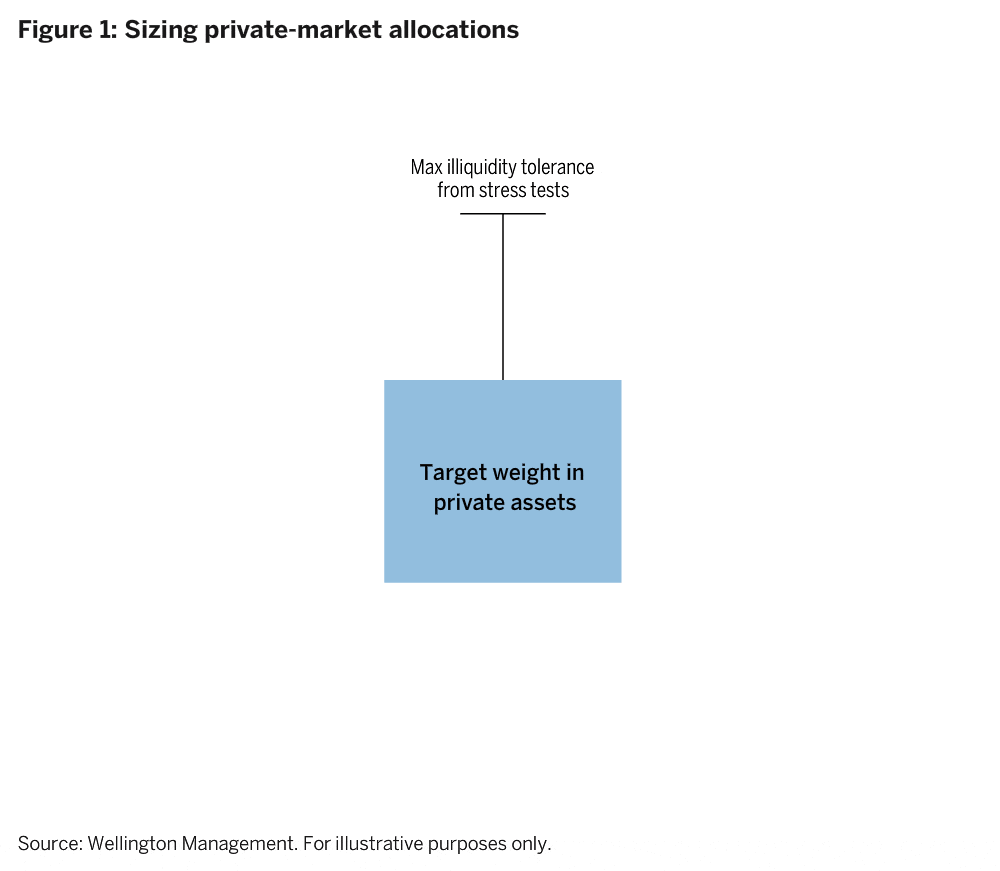- Multi-Asset Portfolio Manager
Skip to main content
- Funds
- Insights
- Capabilities
- About Us
- My Account
The views expressed are those of the author at the time of writing. Other teams may hold different views and make different investment decisions. The value of your investment may become worth more or less than at the time of original investment. While any third-party data used is considered reliable, its accuracy is not guaranteed. For professional, institutional, or accredited investors only.
Interest in private-market allocations appears to continue its steady ascent in 2025. Historical returns and diversification potential are attracting a wide variety of asset owners, who are accessing everything from early-stage venture capital to investment-grade private placements through an expanding set of vehicles.
But critically, asset owners are often less familiar with how to properly size these private-market allocations to meet their portfolios’ distinct objectives. In this paper, we provide an actionable framework to help asset owners evaluate three core components of this decision: the capacity to take on illiquidity, the need for excess return and the ability to consistently allocate to “good” investments.
Here, we highlight the main reasons we think asset owners allocate to private assets, introduce our approach to sizing private investments and outline three key components.
In our view, private investing can offer asset owners a range of attractive characteristics, including the potential for return premia and greater diversification and breadth of opportunity set.
Return premia
Private assets are characterised by illiquidity and have historically commanded a premium (excess return) that asset owners can capture if their portfolios can tolerate that illiquidity. Moreover, premia from factor risk, idiosyncratic risk and manager skill1 can also be outsized due to the complexity, concentration and dispersion of private-investment vehicles or underlying investments. As we outline below, private-market investors should confirm and quantify their need for excess return to reach their goals, as well as their ability to align the longer investment horizons with their own portfolio needs.
Diversification and breadth
Notably, illiquidity risk can also diversify market beta risk (i.e., asset owners can potentially take less market risk and more illiquidity risk to get to the same return target). In addition, even if a public-market strategic asset allocation (SAA) provides sufficient return, an allocation to privates may offer diversification and breadth. This is because private investments can provide access to earlier-stage companies, different sectors or other market segments that may be hard to access in a public-market portfolio. With companies staying private longer and the number of public companies shrinking, part of the opportunity set previously available in the small-cap listed market is now likely to be found in the pre-IPO or late-stage VC market. Importantly, some asset owners have been attracted by the additional perceived volatility benefit of private investing’s “smoother ride” given infrequent pricing. We would caution that this benefit only exists on paper in that it can’t be realised by rebalancing or selling.
For most asset owners, we believe in an opportunity-cost approach to sizing private assets. Crucially, this means we do not incorporate private assets directly into our SAA process. Instead, we consider sizing them in a follow-on step. First, we use the SAA process to determine the long-term target liquid beta exposure of a portfolio. Subsequently, when considering portfolio construction and implementation, we evaluate and structure private allocations according to the criteria we outline below. We frame the source of funding for each private investment as its “opportunity cost.”
Why do we have a separate process for determining the sizing of private assets outside of SAA to begin with? Private assets have several qualities we believe make them poor fits for inclusion in a mean-variance-based asset allocation process:
With these factors in mind, and because private assets are such a wide-ranging category, we prefer to decompose their return and risk profiles into what we can measure as beta and “other” (with “other” including illiquidity premia and idiosyncratic risk). This gives us a framework to align public- and private-market exposures within broad asset class types (e.g., thinking about private equity holistically within a total equity allocation). We then decide within each of those asset class exposures what the best implementation blend is (i.e., private versus public) as well as the choice of managers. We believe this approach has significant benefits for investment governance because it takes into account the specific characteristics of private assets, which often require a more tailored approach.
What does this look like in practice? We believe the sizing of private assets within an SAA should be based on the asset owner’s:

Below, we introduce each component in turn.
1. Capacity to take on illiquidity and complexity
We believe the upper bound of the private asset allocation weight should be based on a practical limitation — how much illiquidity can an asset owner reasonably take on? Given illiquidity is a core characteristic and a key return driver for private assets, it is critical to confirm that a portfolio has the capacity to handle this risk. There are three main types of liquidity constraints that can impact sizing:
The goal of this step is to evaluate the potential negative impacts related to illiquidity — largely through stress testing — and thereby set the upper bound for the allocation weight to private assets.
2. Need for excess return
We believe the lower bound of a private asset allocation should be based on a portfolio’s distinct need for excess return (combined with the size of the premium available). This part of the sizing exercise seeks to analyse whether the asset owner can achieve their objectives without taking on the illiquidity and complexity of private assets. The answer to this question helps identify a minimum allocation because if the portfolio does, in fact, need more return, it will likely be necessary to increase risk, either through higher risk (e.g., in equities) or illiquidity.
To rationalise an investment in private assets, the asset owner should believe the risk-adjusted return premia noted above exists, is durable and is capturable. One key question is how large of a premium one can expect. Estimates of return premia from private assets have generally ranged from as low as 2% to as high as 6+%, depending on the time period, the specific subasset class and the methodology used. We believe in taking a conservative approach and assume 2% premia for broad private debt and 3% premia for broad private equity. However, we view these as general starting points, and it may be reasonable for individual asset owners to make different assumptions based on their experience and/or the asset category in question.
The goal of this step is threefold: 1) to provide guidance on a reasonable starting point for assumed premia, 2) to evaluate how different premia assumptions imply different allocation weights to private assets and 3) to evaluate trade-offs between market and illiquidity risk when seeking alternative sources of return. Weighing these factors together can help identify the minimum private-market allocation necessary to achieve the asset owner’s goals.
3. Ability to source, select and allocate consistently to “good” funds/investments
Finally, private investing’s breadth, heterogeneity and skill requirements have a crucial consequence: returns have exhibited significant dispersion due to manager and strategy selection historically. This has meant that asset owners with the ability to source, select and allocate consistently to the “best” managers have often earned outsized excess returns.
The goal of this step is to provide data to contextualise the importance of manager selection and vintage-year diversification. After all, once an asset owner has determined the maximum percentage that can be allocated to privates (the upper bound) and the amount of additional return needed (and thereby the lower bound), the focus can turn to implementation. Where one sits within that range will depend on the capability not just to source and select “good” managers but also to run a long-term program at the appropriate size.
In our view, evaluating the capacity to take on illiquidity (the upper bound), the need for return premia (the lower bound) and the ability to source, select and allocate consistently to “good” managers (where one lands within that range) – and then combining these criteria – can help asset owners better size their private-market allocations to align with their long-term portfolio goals.
Our key takeaways for asset owners are:
1Some premia may be linked to specific attributes of how value is added to private assets, which are not available in the listed space. For example, in venture capital, this may be the value added by a long-term capital partner to prepare the company to go public. Additionally, some portion of the private debt premium may be linked to the fact that borrowers are willing to pay a higher yield for flexibility on covenants and deal structure. | 2The denominator effect in this case refers to when public assets decrease in value to a greater degree or faster rate than the private assets in a portfolio — thus causing private assets to represent a larger percentage of overall asset allocation than may have originally been intended.
Expert

Private credit outlook for 2026: 5 key trends
Continue readingVenture capital outlook for 2026: 5 key trends
Continue readingPrivate real estate debt: An evolving opportunity set
Continue readingInvesting in climate solutions across public and private markets
Continue readingHuman capital management for private companies
Continue readingWhat’s the Fed got to do with it? The impact of rate cuts on CLO equity
Continue readingCommercial real estate debt: Transitional assets deep dive
Continue readingURL References
Related Insights
Stay up to date with the latest market insights and our point of view.